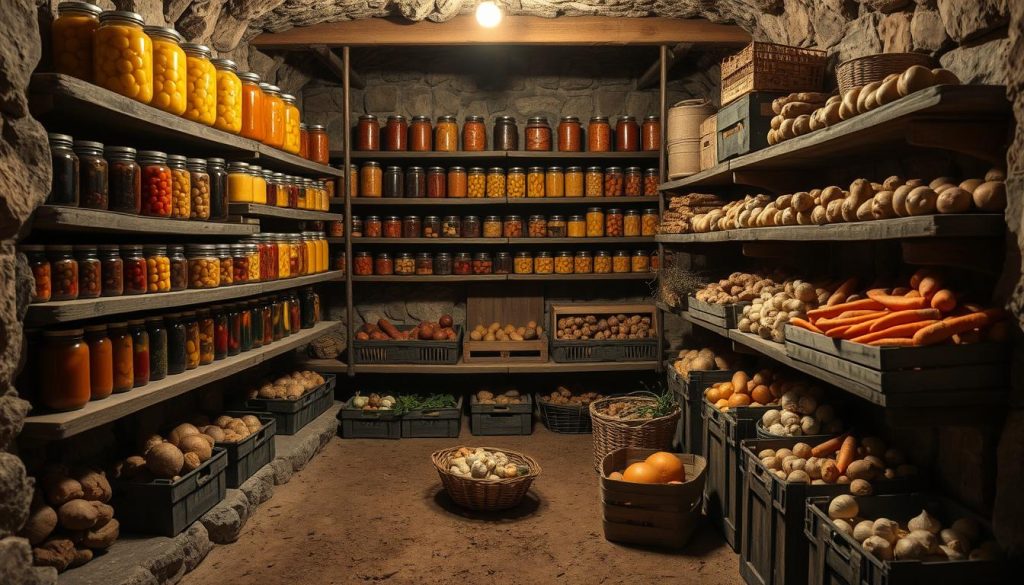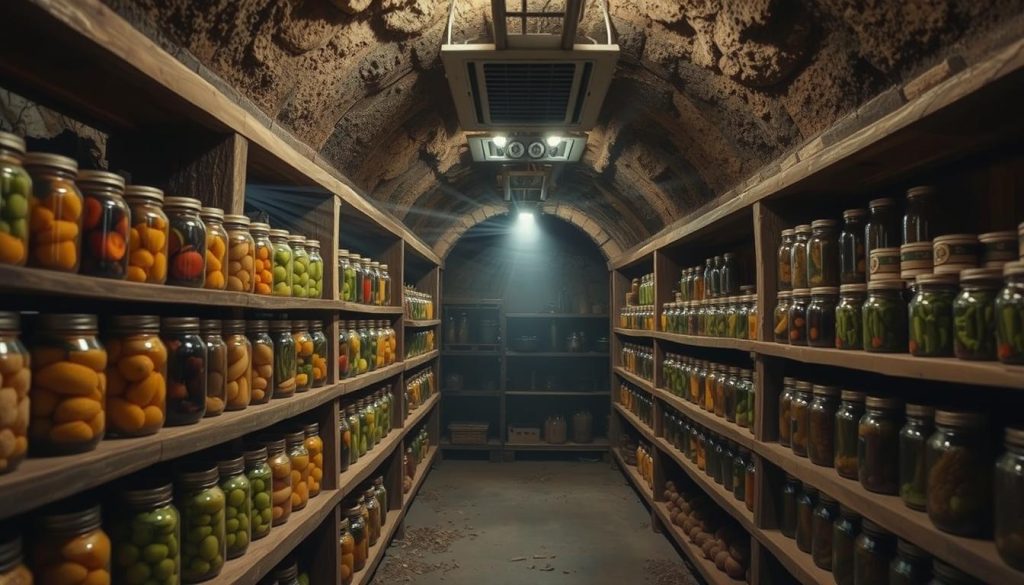Welcome to the essential guide for root cellar upkeep! Keeping a root cellar in good shape is key for storing vegetables long-term. This guide will show you how to keep your harvest fresh and prevent spoilage. By using these tips, you can make your stored produce last longer and enjoy it for months.
Understanding the Basics of Root Cellars
Root cellars are key for underground storage, using the earth’s natural cooling. They are a cost-effective way to keep food fresh. This includes fresh produce, meats, and canned goods.
What is a Root Cellar?
A root cellar is a cool, humid space under the ground. It’s designed to keep food fresh for a long time. The temperature stays between 32°F and 40°F, and humidity is high.
This method has been used for centuries. It’s seen in ancient Chinese and early American cultures.
Benefits of Using a Root Cellar
Using a root cellar has many benefits. It helps save energy and money. It also keeps food fresh, reducing waste.
It’s a smart choice for those who want to save money. It lowers energy bills and keeps food from spoiling.
Ideal Conditions for a Successful Root Cellar
Creating the perfect environment in your root cellar is key to its success. It’s all about the right mix of temperature and humidity. This combo keeps your food fresh for longer. Knowing the details helps you set up the best storage space.
Temperature Control
Keeping the temperature just right is essential. The ideal range is 32-40°F (0-4°C). It’s important to check the temperature often to keep it steady. Changes can cause food to spoil too soon.
Using an insulated door and walls helps control the climate. This keeps your cellar at the perfect temperature.
Humidity Levels
Humidity is also crucial for your root cellar. You want a relative humidity of 85-95%. This keeps your food firm and fresh. Too much moisture can lead to mold, while too little causes food to dry out.
To balance humidity, you can use a humidifier or water pans. Reading up on agriculture can give you more tips for managing your cellar’s climate.
Seasonal Maintenance Tasks for Your Root Cellar
As seasons change, so do the needs for your root cellar. Whether it’s summer or winter, the right strategies keep your food fresh. Here’s a guide on managing your root cellar through the seasons.
Summer Prep: Keeping It Cool
Summer brings high temperatures that can harm your root cellar. Use geo-cooling methods to keep it cool. Insulating walls and doors helps a lot. Also, natural ventilation with vents and fans is key to prevent heat.
Here are some summer tips:
- Install reflective barriers to reduce heat.
- Add shading or awnings to protect doors and windows.
- Seal all entrances and voids to keep warm air out.
Winterizing Your Root Cellar
Winter needs a different plan to protect your food from freezing. Start by checking the insulation and fixing any issues. Adding more insulation or thermal blankets helps keep the temperature right.
Here’s how to winterize your root cellar:
- Seal gaps and cracks to block cold drafts.
- Add thicker insulation to walls, doors, and ceiling.
- Use a passive solar air heater to keep it warm without power.
By following these tips, you can keep your food fresh all year.
Organizing Your Root Cellar Efficiently

It’s key to make your root cellar layout work well to keep your harvest fresh. Good food storage helps your veggies stay good for longer. This means they’ll taste better and last longer.
Storage Tips for Different Vegetables
Each veggie has its own storage needs. Knowing these helps you set up your root cellar right. For example, carrots, beets, and parsnips do well in sand or sawdust to keep moisture even.
Leafy greens need cooler spots with lots of humidity. They should go in bins that let air through.
Create a Rotation System
Having a rotation system is crucial. It means always putting new items behind the old ones. This way, you use the oldest first, cutting down on waste and keeping food fresh.
Use labels and dates to keep track of what you have. It makes managing your food easier and helps you find what you need quickly.
Identifying Common Issues in Root Cellars
Keeping a root cellar in good shape means knowing how to store food and spotting problems early. I’ll cover common issues like mold, mildew, and pests.
Mold and Mildew Prevention
Mold and mildew can grow if your root cellar is too damp. It’s important to keep it dry. Make sure it’s well-ventilated to avoid moisture buildup.
Check for leaks or condensation that might cause mold. A humidity gauge can help you keep the right moisture level.
Pest Control Strategies
Pests like rodents and insects can damage your root cellar if not controlled. It’s key to keep them out. Seal any gaps or holes to block their entry.
Use traps and natural repellents like peppermint oil or diatomaceous earth. Regularly check and clean your cellar to catch pests early.
Cleaning Your Root Cellar: A Step-by-Step Guide

Keeping your root cellar clean is key to keeping your food fresh. By using effective cleaning practices, you can stop spoilage and keep it clean. Here’s a detailed guide on what you need and how to clean for the best root cellar sanitation.
Supplies You’ll Need
To start, you’ll need these items:
- Natural disinfectants like white vinegar or hydrogen peroxide
- Cleaning brushes of different sizes
- Microfiber cloths
- Protective gloves
- A bucket of warm water
Cleaning Techniques
With your supplies ready, follow these steps for a clean root cellar:
- Remove all stored items: First, take out all produce and shelves for full access.
- Dust and sweep: Use a broom and dustpan to remove dust and debris from floors and walls.
- Scrub surfaces: Mix warm water with a natural disinfectant in a bucket. Use a brush to clean walls, floors, and ceiling.
- Clean shelving: Don’t forget to disinfect shelves. Wipe them down with a cloth soaked in your chosen natural disinfectant.
- Dry thoroughly: Let surfaces air dry or use a dry cloth to speed up drying.
- Replace items: After drying, put shelves back and restock your items. Make sure they’re clean before storing.
These effective cleaning practices ensure your root cellar sanitation stays high. This keeps your food safe and fresh for longer.
Choosing the Right Location for Your Root Cellar
Choosing the right spot for your root cellar is key. It affects how well it works and lasts. Let’s look at what you need to think about for the best spot.
Factors to Consider
Several things are important when picking a spot for your root cellar:
- Elevation: A higher spot helps with drainage. This keeps your food dry and safe from water damage.
- Proximity: Pick a spot close to your house. This makes it easy to get to all year.
- Climate: Think about your local weather. Good airflow and insulation help keep the cellar just right.
Best Types of Ground
The ground you choose affects your root cellar’s performance. Here are tips for the best soil:
- Clay Soil: Clay is great for keeping things cool but needs good drainage to avoid water problems.
- Sandy Soil: Sandy soil drains well but might need extra insulation to stay cool.
- Loamy Soil: Loam is often the best choice. It keeps moisture right and drains well.
Enhancing Ventilation in Your Root Cellar

Proper ventilation is key for a great root cellar. It helps control temperature and humidity, keeping your food fresh all year. Let’s explore the role of airflow and simple DIY ways to improve it.
Importance of Airflow
Good airflow prevents moisture and heat buildup. This keeps your food quality high. A well-ventilated cellar uses natural cooling to keep it cool and consistent.
DIY Ventilation Solutions
There are easy DIY ways to improve ventilation. Here are some ideas:
- Install intake and exhaust vents: Put intake vents near the floor for cool air. Use exhaust vents near the ceiling for warm air.
- Utilize natural airflow patterns: Place vents to catch wind and air currents.
- Add floor grates: Grates on the floor help air move around.
- Integrate fans for forced air: Small fans can help when natural air isn’t enough.
These DIY solutions can make your root cellar perfect for storing food.
Special Considerations for Different Items
Maximizing your root cellar’s efficiency and safety means knowing how to store different items. Each type of produce and preserved good has its own needs. This ensures they stay fresh and safe to eat.
Storing Fruits vs. Vegetables
Fruits and vegetables need different storage methods. This is because fruits release ethylene gas, which can make vegetables ripen faster. So, it’s best to store them separately.
- Fruits: Use containers that breathe and keep a bit more humidity. But don’t let moisture build up.
- Vegetables: Use sand or sawdust to keep them cool and dry. This stops them from sprouting.
For fruits, check them often for signs of spoilage. Vegetables need a cooler, drier spot. Following these tips helps keep your food fresh longer.
Preserving Canned Goods
Keeping canned food safe in your root cellar is key. First, keep the area clean and dry to avoid rust. Also, organize your cans so you use the oldest ones first. This keeps your food fresh.
- Check the seals on your cans often and throw away any that look bad.
- Label each can with when you canned it. Use the oldest ones first to keep your food safe.
By following these tips, you can store many different items well. Properly storing fruits and keeping canned goods safe makes your root cellar a great place for all your food.
Maintaining Your Root Cellar Year-Round
To keep your root cellar working well all year, you need a steady plan. Regular care helps keep your cellar in great shape. I’ll show you how to check it often and set up a maintenance plan.
Regular Inspections
Regular checks are crucial for your cellar’s health. Spend a few hours each month looking for mold, pests, and structural issues. Also, watch the temperature and humidity, as they change with the seasons.
Spotting problems early helps avoid big issues. This way, your cellar stays a trusted place for storing food.
Keeping a Maintenance Schedule
Having a maintenance schedule is essential. Plan tasks for different seasons, like cooling in summer and winterizing. Keep a record of your checks and any fixes.
This keeps you organized and lets you see how your cellar is doing. It helps you avoid surprises and keeps your cellar ready for you all year.

